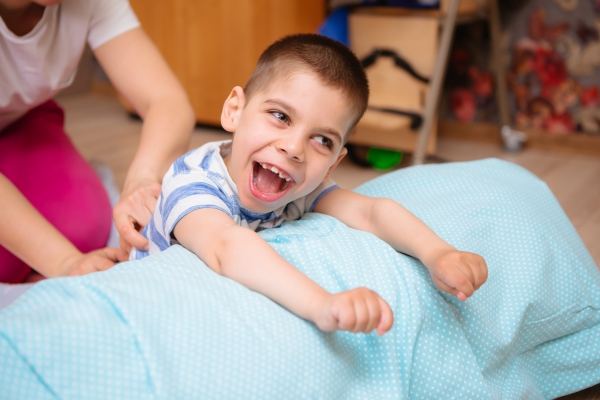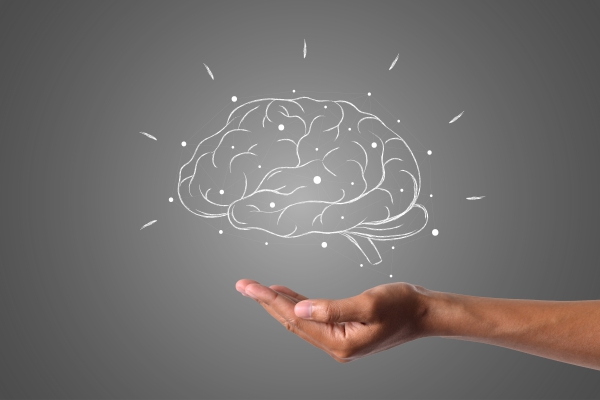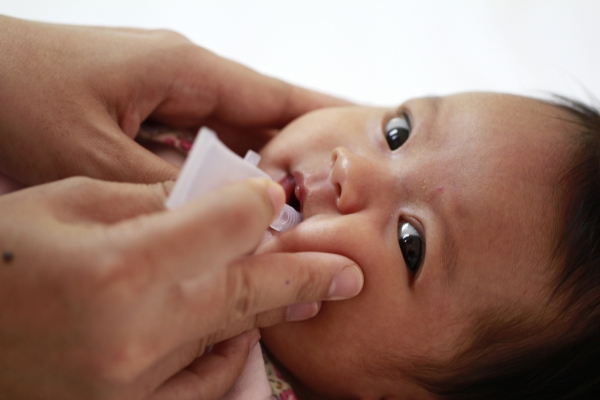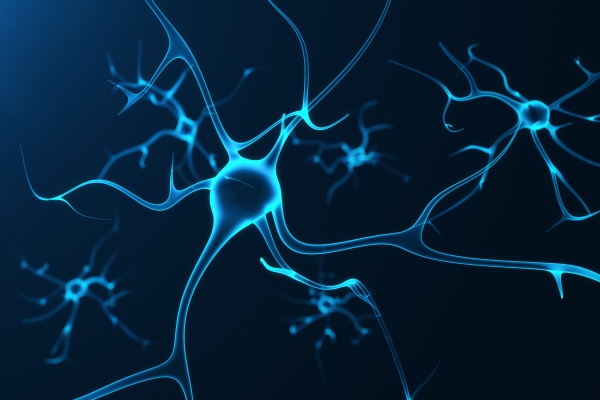What is cerebral palsy?
Cerebral palsy is a group of disorders that affect posture, muscle tone, movement and development. This condition occurs when the immature brain is damaged as it develops, most commonly before birth. This damage may occur due to vascular insufficiency- reduced supply of oxygen to the brain- or due to infections or toxins. The signs and symptoms of cerebral palsy usually becomes apparent during infancy or preschool years and include rigidity of the limbs and trunks, abnormal reflexes, involuntary movements, abnormal posture, unsteady walking and growth disturbances. In addition, people affected by cerebral palsy can have swallowing difficulties, eye muscle imbalance and a reduced range of motion at various joints of their body due to muscle stiffness. Furthermore, other people affected by this condition may have intellectual disabilities and suffer from blindness, epilepsy or deafness.
In developed countries, it is estimated that cerebral palsy affects around 2-2.5 cases per 1000 live births. In addition, all races are affected by this condition. Furthermore, lower socioeconomic status and male sex are at increased risk of developing cerebral palsy. The initiating event leading to cerebral palsy can occur anytime between prenatal (before birth) development and age 3 years. Usually, children are not diagnosed until after the age of 1 year, as children fail to meet developmental milestones.
What are the causes and risk factors of cerebral palsy?

Cerebral palsy occurs when there is damage or disruption in brain development. In many cases the exact cause is unknown. However, there are several factors which may increase the risk of developing cerebral palsy. The risk factors may be categorised into maternal, prenatal (before pregnancy), gestational (time between conception and birth), perinatal (the period from 22 weeks of pregnancy to 7 days after birth) and postnatal factors (after birth of baby).
The maternal and prenatal risk factors for cerebral palsy include:
- Long menstrual cycle.
- Previous pregnancy loss.
- Previous loss of newborn.
- Maternal mental retardation.
- Maternal seizure disorder.
- Maternal thyroid disorder (iodine deficiency).
- History of delivering a child below 2000 grams.
- History of delivery a child with mental retardation, sensory or motor (movement) deficit.
- Infections such as cytomegalovirus, rubella, herpes, syphilis, toxoplasmosis and zika virus infection.
The gestational risk factors for cerebral palsy include:
- Polyhydramnios which is the excessive accumulation of amniotic fluid- the fluid which surrounds the baby in the uterus during pregnancy.
- Maternal seizure disorder.
- Management of the mother with estrogen, progesterone or thyroid hormone.
- Maternal high blood pressure.
- Maternal severe proteinuria which is the excessive loss of protein in urine.
- Congenital malformation of the foetus (a foetus is the baby from 8 weeks of pregnancy until birth).
- Male sex of the foetus.
- Bleeding in the third trimester (from 28 weeks of pregnancy until birth).
- Intrauterine growth retardation which refers to poor growth of a foetus while in the mother’s womb during pregnancy.
- Pregnancy with more than one baby at a time.

The perinatal risk factors for cerebral palsy include:
- Prematurity.
- Chorioamnionitis which is a bacterial infection that occurs before or during labour.
- Abnormal presentation or positioning of the baby during birth whereby the baby is feet-first rather than headfirst.
- Birth asphyxia which is a medical condition resulting from deprivation of oxygen to a newborn that lasts long enough during the birth process to cause harm to the brain.
The postnatal risk factors for cerebral palsy include:
- Infections such as encephalitis (infection of the brain) or meningitis (infection of the tissues surrounding the brain).
- Periventricular leukomalacia which is a type of brain injuring affecting premature infants causing the death of the brain’s white matter.
- Intracranial haemorrhage which is bleeding inside the brain due to blood vessel malformations or trauma.
- Persistent foetal circulation or persistent pulmonary hypertension of the newborn which will deprive the brain of oxygen.
- Kernicterus which is a type of brain damage in a newborn with severe jaundice (yellowing of the skin and the whites of the eyes).

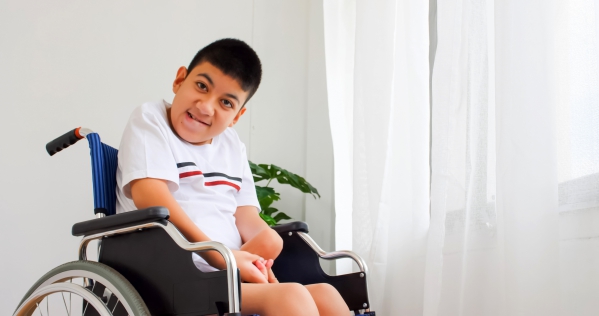
What are the signs and symptoms of cerebral palsy?
The signs and symptoms of cerebral palsy varies and include:
- Stiff or floppy limbs.
- Stiff muscles and exaggerated or normal reflexes.
- Lack of muscle coordination and balance.
- Slow movements.
- Involuntary movements.
- Difficulty walking with abnormal gait.
- Delays in motor skills milestones such as sitting up, crawling or pushing up on arms.
- Difficulty sucking or eating.
- Swallowing problems.
- Learning difficulties.
- Seizures.
Cerebral palsy may affect the whole body or parts of the body. In addition, the signs and symptoms does not get worse with time. However, as the child grows, some symptoms may become less or more apparent.
There are some condition which may resemble cerebral palsy and these include:
- Intellectual disability.
- Metabolic neuropathy.
- Inherited metabolic disorders.
- Traumatic peripheral nerve lesions.
- Metabolic myopathies.
- Tumours of the conus and cauda equina.
- Vascular malformations of the spinal cord.
Making a diagnosis
The signs and symptoms of cerebral palsy may become apparent after a few months after birth. To make a diagnosis, your doctor will first take a detailed history from you to know more about your risk factors and the symptoms of your baby. After the history taking, your doctor will perform a thorough physical examination to look for signs of cerebral palsy. To confirm the diagnosis, your doctor will order some tests which include:

- Laboratory tests: There are no definitive laboratory studies for diagnosing cerebral palsy but some may prove to be useful to rule out other disorders and include thyroid function tests, ammonia levels, lactate levels, amino acids level, chromosomal analysis and cerebrospinal protein levels.
- Electroencephalography (EEG): An EEG is done to evaluate your child’s brain electrical activity if he/she is having seizures.
- Cranial ultrasound: This done uses sound waves to produce images of the brain to assess for any abnormality within the brain.
- Magnetic Resonance Imaging (MRI) scan of the brain: This imaging test is the imaging study of choice in children above 1 month of age and it helps to identify any congenital malformations, intracranial haemorrhage and periventricular leukomalacia.
Once the diagnosis of cerebral palsy is made, your doctor will refer your child to a specialist who will test your child’s hearing, vision, speech, intellect, development and movement.
What are the treatments of cerebral palsy?
The management of cerebral palsy mainly include medications, therapies and surgery.
The medications used in the management of cerebral palsy are given to reduce muscle tightness, treat pain and improve functional abilities. These include:
- Muscle injections: In order to reduce the tightness of a specific muscle, your doctor may recommend injections of onabotulinumtoxinA or another injection. These injections are given every 3 months. However, it may have some side effects such as pain at the injection site, difficulty breathing and swallowing.
- Oral muscle relaxants: Medications such as diazepam, baclofen, dantrolene or tizanidine are often used to relax the muscles. However, the use of these medications should be closely monitored as it may become addictive.

There are several therapies which may play an important role in the management of cerebral palsy and these include:
- Physical therapy: This therapy involves muscle training and exercises to help your child gaining strength, flexibility, mobility and balance.
- Occupational therapy: Occupational therapists will help your child by providing equipment such as walkers, quadrupedal canes, seating systems and electric wheelchairs to help your child gain independence in daily activities and routines at home, school and in the community.
- Recreational therapy: This type of therapy improves your child’s motor skills, speech an emotional well-being by providing them with activities such as skiing or therapeutic horseback riding.
- Language and speech therapy: This type of therapy will improve your child’s ability to speak clearly or communicate using sign language. If communication is still difficult, communication devices such as computer or voice synthesizer may be used.
In certain cases, surgical procedures may be required to correct bone abnormalities or reduce muscle tightness and these include:
- Selective dorsal rhizotomy: This surgical procedure involves your surgeon cutting nerve fibres connected to the stiff muscles which relaxes the muscles and reduce pain. However, it may cause numbness.
- Orthopaedic surgery: Orthopaedic surgery may be required to place their hips, legs, or arms in the correct position. These corrections will improve mobility and reduce pain.

What are the complications of cerebral palsy?
If cerebral palsy is left untreated, the following complications may ensue:
- Contracture: Contracture is when muscle tissue shortens due to severe muscle tightening which can inhibit growth and cause bones to bend resulting in dislocation and joint deformities.
- Premature ageing: This occurs due to the great stress cerebral palsy put their body into.
- Mental health conditions: People with cerebral palsy often suffer from depression which may result in social isolation.
- Malnutrition: Due to swallowing difficulty, it is difficult for someone with cerebral palsy to feed, resulting in malnutrition.
- Heart disease.
- Lung disease.
- Osteoarthritis: Misalignment of the joint and the excessive pressure imposed on the joints may lead to painful degenerative bone disease.
- Osteopenia: Due to malnutrition and low bone density, people with cerebral palsy may be susceptible to fractures.
Expectations (prognosis)
People suffering from cerebral palsy may fully integrate academically and socially with the appropriate therapeutic services. Unfortunately, the overall rate of mental retardation in affected persons is thought to be 30-50%. In addition, 25% of children with cerebral palsy are unable to walk. Obtaining a diagnosis early is important to start to management early in order to prevent complications and to give the child all the chance to gain independence in the future.


Source:
J. Alastair, I. and Simon, M., 2016. Davidson's Essentials of Medicine. 2nd ed. London: ELSEVIER.
Parveen, K. and Michael, C., 2017. Kumar & Clarks Clinical Medicine. 9th ed. The Netherlands: ELSEVIER.
Abdel-Hamid, H., 2018. Cerebral Palsy.
Shevell MI, Bodensteiner JB. Cerebral palsy: defining the problem. Semin Pediatr Neurol. 2004 Mar. 11(1):2-4.
Jacobsson B, Hagberg G. Antenatal risk factors for cerebral palsy. Best Pract Res Clin Obstet Gynaecol. 2004 Jun. 18(3):425-36.
Volpe JJ. Neurology of the Newborn. 4th ed. Philadelphia, Pa: WB Saunders; 2001. 4.
Capute AJ, Accardo PJ, eds. Developmental Disabilities in infancy and Childhood. 2nd ed. Baltimore, Md: Brookes Publishing; 2001. Vol 2.
